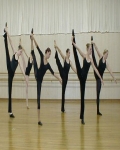|
Jazz Dance
International Dance Styles >> Jazz Dance
History:
The history of jazz dancing is tremendously
distinctive in that it has developed through the influence
of more than a few other dance styles and techniques.
It developed alongside the American jazz music
ethnicity and like jazz music, has its roots
in African and slave ethnicity. Later, though, it became entangled
with tap, Minstrel shows, vaudeville, swing,
and Broadway. In result, the movements and styles allied with
jazz dancing have been continuously varying
over the decades.
The
untimely 20th Century:
On the journey to America, slaves in the
1800s were permitted to dance in order to
keep fit. These dances sustained on the plantations in the
American South.
|  In the early 1900s, as black Americans
became the precursors of the jazz movement;
jazz dancing was very closely associated to tap
dancing. In fact, a jazz or tap dancer was
conventionally part of a jazz band,
and these dance trends soon spread to the audience and
the public. The consequence was dances like the Charleston,
Jitterbug, Boogie Woogie, and Swing Dance
In the early 1900s, as black Americans
became the precursors of the jazz movement;
jazz dancing was very closely associated to tap
dancing. In fact, a jazz or tap dancer was
conventionally part of a jazz band,
and these dance trends soon spread to the audience and
the public. The consequence was dances like the Charleston,
Jitterbug, Boogie Woogie, and Swing Dance
|
Earlier period Meets
Present:
Todays jazz styles array from those slinky Broadway-inspired movements, to a more lyrical or balletic style, to comprise even hip-hop based video dance, which takes influence from street dance methods and techniques. Fundamental jazz technique is still based
on the mastery of turns, leaps, kicks, and fluid style, but
every jazz class and jazz teacher is distinctive.
While a few may favor the theatrical end of the spectrum,
others may choose for harder and faster movements
that combine hip hop moves with conventional jazz
steps. On the other hand, jazz dance
carry on to be a genre which can differ according to contemporary
trends, while upholding strong and consistent foundation.
|